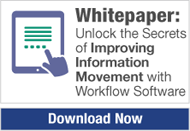The document management system has been revolutionized, to put it lightly, by Software as a Service (SaaS) and cloud computing: streamlining services, cutting costs and customizing the user experience.
What is SaaS?
SaaS, Software as a Service, is a software distribution model in which applications and data are hosted in the cloud (i.e., internet) by a vendor or service provider and delivered as a subscription. This takes a great deal of hassle and frustration off your plate.
- All services are readily available to you, the consumer, via a web browser.
- The cloud vendor, not you, is responsible for hardware maintenance and costs.
- The SaaS vendor, not you, is responsible for maintenance of the application or servers that the software runs on and requires.
- You don’t need to worry about updating your system, monitoring the servers/network or upgrading the application.
- If done correctly, you do not have to worry about if the main cloud infrastructure goes down whether your date has multiple levels of redundancy. If it goes down it should automatically switch to one of many locations where it is copied for your immediate access.
- Think of it like an electricity grid: You only pay for what you use – no more, no less.
SaaS document, workflow and compliance management is really the only way to go.
If you’re after sleek and streamlined system that keeps costs down and productivity up, then a SaaS document management and workflow system is for you.
- It takes the lower cost route.
A SaaS document management system costs much less than an on-premise arrangement because you don’t have to deal with three heavy-hitting expense categories: hardware (e.g., up-front capital investment and long-term equipment management and ongoing replacement), operation (e.g., server upgrades and maintenance) and software maintenance (e.g., multiple updates and virus protection).
You will also need to factor in the annual software maintenance fee which is typically 20% of the license cost and the time in costs in doing the update.) How do we know this? Because we started out selling on premise or license based software so we know the time and costs involved for the customers.
- It makes it easy for you.
With SaaS, the vendor manages the deployment work for you; there is no server preparation, configuration or software initialization. No need to waste your technical team’s time; no need to hire a third party if you don’t have an IT department. All you have to do is agree to the terms and sign the dotted line and start automating.
- It plays nice with other applications.
It used to be that document, workflow and compliance management software only integrated with your existing applications if it was deployed on premise. That is no longer the case. With increasingly sophisticated connectors and bridges (the software that connects two or more physically separated applications), you’re able to connect your own applications with the leaner SaaS solution.
- It looks out for your security.
No doubt about it: It’s essential these days to have a central repository where all of your documents are searchable, retrievable and secure. With a SaaS application, you don’t have to worry about providing the proper security measures to the software application. That’s the vendor’s job, especially given that they probably have more resources to spend on the latest security.
- It locks the data down when disaster strikes.
Having your information backed up off site in multiple locations (redundancy) (i.e., via the provider in the cloud) is a must-have for disaster recovery, security and data-loss mitigation. An on-premise system, on the other hand, mandates that you implement regular back-ups and devise a robust recovery strategy on your own.
SaaS document management is so much more than just “folders in the cloud.”
SaaS document management is your one-stop shop for information organization, process improvement, compliance management and workplace productivity.
- It is structured with information management metadata so you’re able to quickly find exactly what you’re looking for – by searching for words and phrases contained in the document and by the metadata tags entered when the document was first stored – even when you have countless pieces of content to sift through.
- It provides document version control so you always know you’re working with the most up to date copy.
- It allows you to set record retention periods so you remain compliant and documents are not disposed before they are allowed with data-preservation regulations.
- It lets you set reminders so you act on documents – whether revising, approving or sending content to the next node in the process flow– on time, every time.
- It allows you to edit, the check out and check in of documents with a single click so only the correct versions of documents are published.
- It keeps track of what changes were made, who made those changes and if/when those changes were approved.
- It lets you easily build out customizable workflow automation for the review and approval of content and graphics.
- It makes it easy and efficient to collaborate with other team members, communicating and notifying users without leaving the system.
- It allows you to use scripting to further customize the system to your specific needs.
- Integration with other line of business applications
- Allows high volume document scanning and processing.
- Encrypts your documents in transit and at rest so that you don’t have to worry about unauthorized access.
Don’t let information pandemonium break down your workflow engine. Click below to download our complimentary guide Improving Information Movement with Workflow Software.

